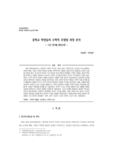

-
 * 본 문서는 배포용으로 복사 및 편집이 불가합니다.
* 본 문서는 배포용으로 복사 및 편집이 불가합니다.
미리보기
서지정보
· 발행기관 : 이화여자대학교 교과교육연구소
· 수록지 정보 : 교과교육학연구 / 16권 / 3호
· 저자명 : 이종희, 이아름
목차
I. 서 론
II. 이론적 배경
III. 연구방법 및 절차
IV. 연구결과
V. 결 론
참고문헌
초록
개정 교육과정에서는 기본적인 수학적 지식과 기능의 습득, 수학적으로 사고하고 의사소통하는
능력의 배양, 사회나 자연의 현상과 문제를 수학적으로 고찰하고 합리적으로 해결하는 능력의 신장
을 목표로 한다. 본 연구의 목적은 사고 양식에 따라 중학교 학생들의 수학적 모델링 과정의 특징
을 분석하고, 모델링 과정에서 나타나는 수학적 사고를 분석하는 것이다. 연구결과는 다음과 같다.
첫째, 시각적 양식의 학생은 모델링 단계에서 상황에 대한 정신적 표상(MRS)과 실제모델 단계를
교대로 풍부하게 사용하는 과정을 보여주었다. 반면, 분석적 양식의 학생은 수학적 모델 단계를 많
이 활용하며 모델링 주기가 시각적 양식의 학생보다 복잡한 주기를 보여주었다. 둘째, 모델링 해결
과정에서 비판적 사고는 조건을 선별하거나 수학적 모델에서 도출된 수학적 결과의 타당성을 논증
할 때, 모델의 적합성을 판단할 때 사용되었다. 유추적 사고는 이전에 풀었던 문제 상황을 모델링
과정에 적용하거나 새로운 모델을 구성할 때 사용되었다. 그리고 모델링 해결에서 필요한 수학교과
외적지식을 탐색하는 과정에서 학생들은 귀납적 사고를 하였다. 또한 구해야 하는 값이나 자신의
모델의 타당성을 논증할 때는 연역적 사고를 사용함이 확인되었다. 모델링과제의 해결 과정에서 학
생들의 사고 양식에 관계없이 연역, 유추, 귀납적 사고와 비판적 사고가 모두 사용되었다.영어초록
The education curriculum that was updated 2011 aims at the acquisition of basic
mathematical knowledge, the development of mathematical-considered communication, and
rational problem-solving ability with respect to society, natural situations, etc. Through
mathematical modelling, students can become aware of the basic structure of situations around
them, search through interesting topics, understand the importance of mathematics, and
reinforce rational thinking about the useful skills needed in their lives.
The purpose of this study was to analyse students' modelling processes and the roles of
mathematical thinking step by step.
The conclusion of this research is as follows.
First, a visual-thinking-style student used both mental representation of the situation and real
model steps. On the other hand, an analytic-thinking-style student frequently used a
mathematical model and demonstrated a more complicated way of solving a problem than a
visual student.
Second, critical thinking from the modelling process was used for filtering the conditions
from real modelling step and reasoning of mathematical result from mathematical model. The
students used inductive reasoning in the investigation and the extra-mathematical knowledge
that is needed in the model solving process. They also used deductive thinking when they
proved the validity of their models.참고자료
· 없음태그
-
자료후기
-
자주묻는질문의 답변을 확인해 주세요

꼭 알아주세요
-
본 학술논문은 (주)학지사와 각 학회간에 저작권계약이 체결된 것으로 AgentSoft가 제공 하고 있습니다.
본 저작물을 불법적으로 이용시는 법적인 제재가 가해질 수 있습니다. -
해피캠퍼스는 구매자와 판매자 모두가 만족하는 서비스가 되도록 노력하고 있으며, 아래의 4가지 자료환불 조건을 꼭 확인해주시기 바랍니다.
파일오류 중복자료 저작권 없음 설명과 실제 내용 불일치 파일의 다운로드가 제대로 되지 않거나 파일형식에 맞는 프로그램으로 정상 작동하지 않는 경우 다른 자료와 70% 이상 내용이 일치하는 경우 (중복임을 확인할 수 있는 근거 필요함) 인터넷의 다른 사이트, 연구기관, 학교, 서적 등의 자료를 도용한 경우 자료의 설명과 실제 자료의 내용이 일치하지 않는 경우
“교과교육학연구”의 다른 논문도 확인해 보세요!
-
English Teaching 에 게재된 말하기 논문 주제 분석 : 1976-2012년에 게재된 논문을 중심으로 28 페이지
그동안 영어교육과 관련된 연구 방법과 전반적인 연구 주제에 관한 분석을 주로 한 논문들은 많 이 있어왔다. 한국의 대표적인 영어교육 학술지인 English Teaching 에 듣기, 말하기, 독해, 작문 등의 분야에서 연구 동향에 관한 연구들이 있어 왔으나 대부분 연구 방법, 연구 주제, 자료수집 유 형, 통계분석기법 등을 전반적으로 다루었고 연구 주.. -
고등학생의 계열 선택 및 과학․수학 선택 과목 이수에 관한 의견 조사 19 페이지
본 연구에서는 고등학생을 대상으로 계열 선택 이유 및 대학 진학 희망 분야를 조사하고 과학, 수학 선택 과목의 이수를 결정하거나 포기한 이유 등을 알아보고자 하였다. 이를 위하여 서울 소재 일반계 고등학교 2학년에 재학 중인 남녀 총 414명을 대상으로 설문을 실시하였다. 설문 결과는 다음과 같다. 첫째, 학생들은 고등학교 계열 및 대학 진학 희망 분.. -
초등학생의 어휘 특성 연구 : 반대말과 비슷한말 검사를 통한 어휘 발달 패턴 및 오류 유형 분석 15 페이지
‘읽기를 위한 학습’에서 ‘학습을 위한’ 도구 교과로의 변환이 이루어지는 초등학교 고학년으로 올 라가면서 어휘의 중요성은 더욱 증가한다. 어휘는 크게 양적 어휘와 질적 어휘로 나눌 수 있으며, 학생들의 어휘 특성을 파악하기 위해서는 양적 어휘 뿐 아니라 질적 어휘 수준도 함께 평가하여야 한다. 따라서 본 연구에서는 초등학교 학생의 질적 어휘 특성을 파.. -
NIE 경험과 중학생의 자기 주도적 학습능력 27 페이지
사회변화와 학습자 중심의 교육 패러다임의 변화로 자기 주도적 학습능력이 요청되고 있다. 그 러나 구체적으로 이를 함양하기 위한 방안에 대한 연구는 미흡한 실정이다. 이에 NIE 경험과 중학 생의 자기 주도적 학습과의 관련성에 대한 조사 연구를 통해 자기 주도적 학습능력 함양을 위한 방안으로서의 NIE의 가능성을 탐색하였다. 연구를 위해 수도권의 중학.. -
초등영어교과와 통합한 TPRS 활용이 초등학생의 영어 리터러시 발달에 미치는 영향 22 페이지
본 연구는 TPRS를 활용한 영어수업 절차를 구안하고, 초등학교 6학년 영어학습에 적용한 TRPS 활용 영어 수업이 리터러시 발달에 미치는 효과를 알아보는데 목적이 있다. 문헌연구를 통한 TPRS 에 대한 이론과 방법을 고찰하고 리터러시와의 연관성을 찾아보았다. 또한 미국과 한국의 선행연구 들을 참고하여 TPRS 수업모형을 설계하고, 초등학교 6학년 ..
문서 초안을 생성해주는 EasyAI

